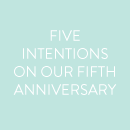30 January 2018
Here we go: week four! Today’s topic is how we handle organization in our personal lives. This could cover a wide range of things, so I’m curious to see what angle Nancy is going to take! :)
To catch up any new gals: Nancy Ray and I are writing an eight-part series every Tuesday in January and February covering “how we do it” in eight different areas: the rhythms, habits, and routines that help us get things done and make the space and time for what matters most. You can read more of the backstory here.
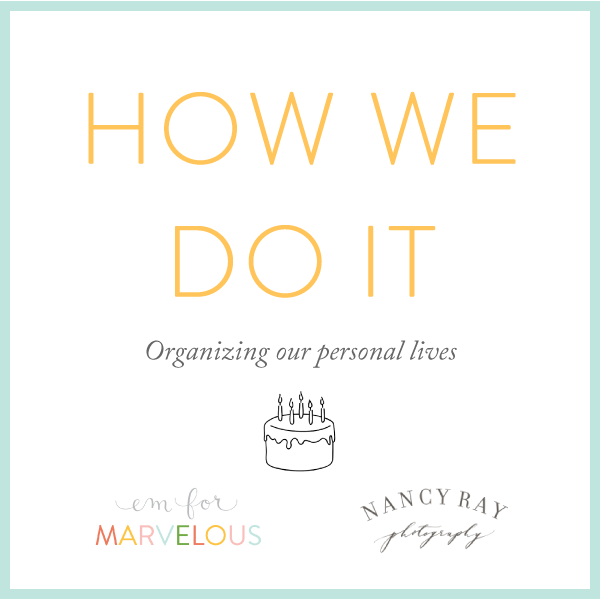
I wanted to start by talking about social media. I promised I would share some of my boundaries in my first How We Do It post, and I’m following through, even though it makes me a little nervous! The reason I’m apprehensive to share is that, similar to my “no” list, even if I take great pains to emphasize that these are choices I have made solely for myself based on my own unique set of circumstances, it’s easy to infer that I somehow disapprove of different choices others make.
Friends, that’s not the case. I want to share because I think I have chosen a bit of a different path, and it’s one that works for me. I am well aware other people have other beliefs, needs, mission statements, and even callings surrounding social media that lead them to make different choices. But, if there’s something within the way I do things that might inspire one of you to think differently or make your own tweak, that’s worth it to me!
I have two Instagram accounts. I opened them at the same time, in 2012 when I began using the platform. One is public, and one is private. (I’m focusing on Instagram because my Twitter and Facebook use are pretty non-existent and Pinterest is just a handy storage spot for me, not somewhere I spend much time!)

The public one (snapshot above) has several thousand followers — mostly people I’ve never met. That is an important point, as most of what I’m going to say below is most pertinent if you, too, have an account followed by strangers (even kind ones!).
The private one has 59 followers, about half of whom are related to me (the rest I would consider my closest friends).
I follow 39 people on the private account (all friends and fam) and 50 on the public one (mostly friends and fam plus about 16 brands or people I don’t know).
Why am I sharing those numbers? My first boundary is that I don’t follow too many people, and I try hard not to follow people who make me feel less-than, covetous, or jealous. I mostly stick to following people who are already in my life and who inspire me!
I chose to have two accounts long before I had a child, so even though I know that’s why most people choose to split their accounts, that was not my primary motivation. (I like sharing a mix of work and home life with y’all!) My split was more about time and expectations.

A snapshot of my private account
During the work day, I’m signed into my public account, and when I leave work, I sign into my private one. Here’s the biggest difference between the two: there are probably 4-5 new posts per day to look at on my private one, as opposed to 20-30 on my public one. There’s just no draw to be checking constantly when at home, because I know there won’t be any new posts!
Similarly, when I post something on my private account say, on a Saturday afternoon, I can post it and go about my business without feeling a need to check back and monitor it to answer questions, gauge the reaction, etc., because there are so few followers (one reason I so strictly limit the number of folks who follow that account). There’s a different level of expectation with my public account. And that’s great — when I’m at work, I have the time to monitor posts and chat with folks, as that is part of my role’s responsibility.
Whew! You with me? :) Honestly, it kind of feels a bit trivial and silly to share all of that (especially since most of these guidelines are pertinent for those who have a public following of some size, and I know that’s not the case for everyone), but when I think about how much angst social media can cause us, perhaps it’s not. Any little tweak that can make it a more positive and less draining aspect of our lives is worth sharing, I hope!
Again, if we have different boundaries, PLEASE don’t feel the need to explain yourself to me!! You do you, girl! :) If you’re comfortable with where you’re at, that’s all that matters to me.
Okay, moving on! The main way I stay organized with all the things on a daily basis is – wait for it – the most old school and basic Word doc on my laptop! Ha! It’s divided into a few sections:
— To Do Today: currently includes “make LL Bean return,” “buy LOVE stamps” (they’re so pretty and I want to stock up!), “order Super Bowl wings,” “buy baby shower gift for Jackie,” and more – there are 18 items on it at the moment
— To Do Soon: things to do in the next few weeks
— Later: things I don’t want to forget but that aren’t of immediate concern
On really busy weeks, I’ll sometimes split out the “to do today” section into “to do today,” “to do tomorrow,” “to do Thursday,” etc.
In addition, I use this same doc to keep track of all sorts of other things, like potential posts for EFM, Etsy orders on deck, and my passwords. (I know that’s not the safest, but it is what it is at the moment!)
I’ve written about my love for the iPhone Notes app before, and it’s still going strong! This incredibly simple and incredibly handy widget helps me seem more together than I am and be a more thoughtful person than I would be otherwise :) A few of my favorite lists: restaurants to try, books to read, books read in 2018, John gift ideas, our chore division, and the food preferences of our friends and family. I also love the Emily Ley tip of starting each list with three corresponding emojis to keep things neat and aesthetically pleasing.
I keep lists that I don’t update so often in Google Docs. Examples include our Christmas card address log, my spreadsheet of Christmas gifts for family and friends, our master packing list for trips, our camping packing list, and my list of favorite excerpts and quotes.
I’m still working on a better and more complete system for organizing our personal photos (a huge goal for this year!). I purchased Nancy’s guide and am on my way, but in the meantime, there is one thing we have down pat. Every January, I order 48 4×4 prints from Social Print Studio – our favorites from the past year. 24 go on the bulletin board in our kitchen, and the rest go into a dish on our coffee table with prints from the last five years. June LOVES looking through them, as do guests!
I’ll leave it there for today! It was hard to know just what to tackle in this post, so if there’s something you’re curious about, don’t hesitate to ask! And don’t forget to check out Nancy’s post here! Thanks for being so wonderful, friends.
The rest of the series:
Time: Em’s post and Nancy’s post
Finances: Em’s post and Nancy’s post
Home: Em’s post and Nancy’s post
Personal Lives: Em’s post and Nancy’s post
Work: Em’s post and Nancy’s post
Relationships: Em’s post and Nancy’s post
Kids: Em’s post and Nancy’s post
Affiliate links are used in this post!
29 January 2018
Friends, today is our 13th dativersary! Lucky 13 :) And wow, do I feel lucky. John is my best friend, my most trusted confidante, a man of great integrity, and the other half of an unbeatable board game duo (ha!).
I am so lucky that HE’S the person I get to do life with. Because of that, I’m always looking for ways to remind him that that’s how I feel – ways to make our marriage even sweeter. I thought of a pretty simple one a few months ago, and I thought I’d share it with y’all in celebration of 13 years!

One of our engagement photos by Gina Zeidler!
I have the privilege of arriving home before John on weekdays. The hour and a half or so before he joins us can be a busy one – playing outside, getting dinner on the table, placating a hungry June, etc. – but there’s one thing I’ve started doing that makes a big difference in how the rest of our evenings together go.
What is it? It’s one thing! :) I try to do one thing every afternoon that will make his re-entry calmer, more pleasant, less stressful, and/or more joyful. Home should be the best place to be, and I want him to feel that as soon as he walks in the door. Sometimes the one thing is tidying the foyer. Sometimes it’s processing the mail so it’s not cluttering the table. Sometimes it’s waiting by the door with June when we hear his car so he has an extra-enthusiastic welcoming committee. (Is there anything better than that?!)
I find that perhaps even more than the “one thing,” the simple act of focusing on someone else’s needs at the end of the day instead of my own moves me to a more generous, patient, and lighthearted head space, and that is definitely a recipe for a happy evening.
As we so often talk about, the big things are usually the little things. It’s a million small actions that add up to a joyful marriage, not a few grand gestures every once in a while. (Though those are, of course, nice, too!)
I’d love to hear one of the small-but-significant ways you love your spouse, if you’d like to share! I learn so much from y’all!
P.S. A few more marriage posts:
Growing together
Lessons from a wedding homily
Marrying the kind one
23 January 2018
Y’all are making this series everything I dreamed of and more, so please, keep chiming in! To catch up any new gals: Nancy Ray and I are writing an eight-part series every Tuesday in January and February covering “how we do it” in eight different areas: the rhythms, habits, and routines that help us get things done and make the space and time for what matters most. You can read more of the backstory here.
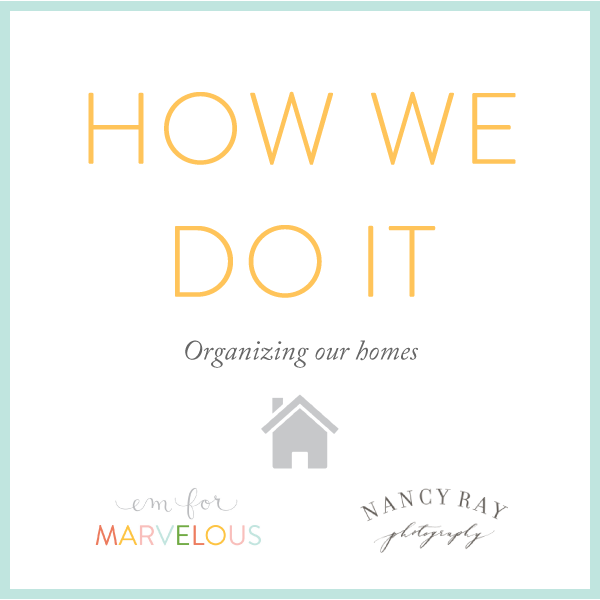
Today’s topic is organization in our homes. With each post so far I’ve shared a few general thoughts before diving into specifics, and today, I wanted to start with the concept of emotional labor. Have y’all read some of the essays that have circled in the last few months? (This was a big one.) They’ve seemed to really resonate with people. Here’s an excerpt in case you’re not familiar:
Then I tried to gingerly explain the concept of emotional labor: that I was the manager of the household, and that being manager was a lot of thankless work. Delegating work to other people, i.e. telling him to do something he should instinctively know to do, is exhausting… He restated that all I ever needed to do was ask him for help, but therein lies the problem. I don’t want to micromanage housework. I want a partner with equal initiative.
Bearing the brunt of all this emotional labor in a household is frustrating. It’s frustrating to be saddled with all of these responsibilities, no one to acknowledge the work you are doing, and no way to change it without a major confrontation… It is difficult to model an egalitarian household for my children when it is clear that I am the household manager, tasked with delegating any and all household responsibilities, or taking on the full load myself.
Here’s the thing: I am unequivocally the household manager in our home. I also don’t find this to be particularly onerous, unreasonable, or unenjoyable. To me, it makes sense that one person would be the point person for information, household organization, and task assignment. And in my marriage, it makes sense that it would be me — because I naturally enjoy it more than John (one of my StrengthsFinder strengths is Input, so I like knowing all the things!); because I work fewer hours than he does; and because I mostly work from home (so it’s easier to do things like call for an appointment over lunch without needing to find a private space from coworkers).

Perhaps I’m happy to be the manager because my work in that role IS seen and appreciated. Perhaps it’s because my husband not only willingly chips in whenever asked but also takes initiative. Perhaps it’s because I’m a realist. Mostly, though, I think it’s because I consider it a privilege. I have exactly the family I’ve dreamed of, and I feel so lucky to be able to take care of them in a million small ways every day. It’s a privilege to help our family run smoothly as a wife and a mama. In a way, it’s been what I’ve been waiting for all my life.
I also want to acknowledge that if you are the household manager but DON’T enjoy your role – perhaps because you’re not appreciated for it, or you’re working more paid hours than your spouse – I hope that you can find a solution that works for your marriage! Just because women most often take on this role doesn’t mean that they HAVE to by natural law or that it can’t be split more equally. The most important thing is finding a solution that works for everyone.
Okay! Enough with the philosophical :) I thought I’d start my tactical tips with cleaning and a few basic household routines, since y’all were intrigued by my claims in my first post! As you’ll see below, we do clean, just perhaps not as often as most people? I don’t know, y’all tell me how we stack up! :) Here’s our typical schedule:
Daily:
Unload and load dishwasher
Wipe down kitchen counters
Tidy main rooms, including processing mail (after June goes to bed)
Pack lunches for the next day
Every weekend:
Wash sheets and towels
Vacuum
Sweep and mop floor (with our Braava!)
Make menu and grocery shop
Every month:
Clean bathrooms
Deeper kitchen clean (microwave, stainless steel, cabinet fronts, etc.)
Seasonally:
Various deep cleaning chores
John and I split these chores — we sat down and divided them up together equitably, based on our preferences, and we are always responsible for the same ones. I think knowing firmly who does each is key, because (in general) we just do them without nagging each other.
Other than sheets, we do laundry collaboratively during the week on an as-needed basis. I know it can be a headache for some people, but it just doesn’t seem to be that big of a deal for us – we just throw it in at some point in the evening whenever needed and tag-team moving it through the cycle of folding and back into the closets.
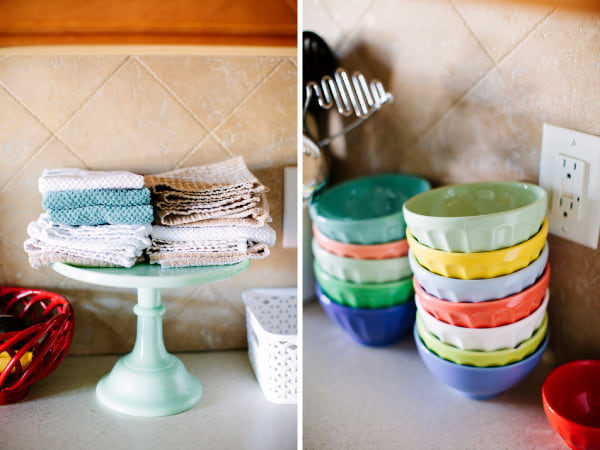
Another big part of keeping our household running smoothly is FOOD! I’ve written about meal planning before, but thought I’d offer an update since things have changed a bit since that 2013 post.
On Friday evening or Saturday morning, I sit down and plan out our meals for the week. Since our default is to make dinner at home, we first look at the calendar and figure out whether there are any days we know we’ll be dining out (maybe dinner at a friend’s house, or a day where we’re running around and don’t have time to cook). We also check to see whether we’re expecting guests any night. Once those are marked on the planning doc, we start filling in meals for the other nights. We pull ideas from Pinterest (meal boards here + here), from our collection of cook books, family recipes from my Kitchen Diary, and from my master recipe list on Google Docs.
Once we have our meals planned and they’re on our Lindsay Letters calendar, I put together a shopping list with any ingredients we need plus anything we’ve added to Alexa’s shopping list during the week. Though we used to shop at various stores in pursuit of the best deal, we’ve opted over the last year to only shop at Publix, which is maximally convenient but a bit more expensive. (We also were just gifted a Costco membership, and so have tentatively dipped a toe in there.) I usually shop during June’s nap on Saturday afternoon, though not always, as you can see below :)
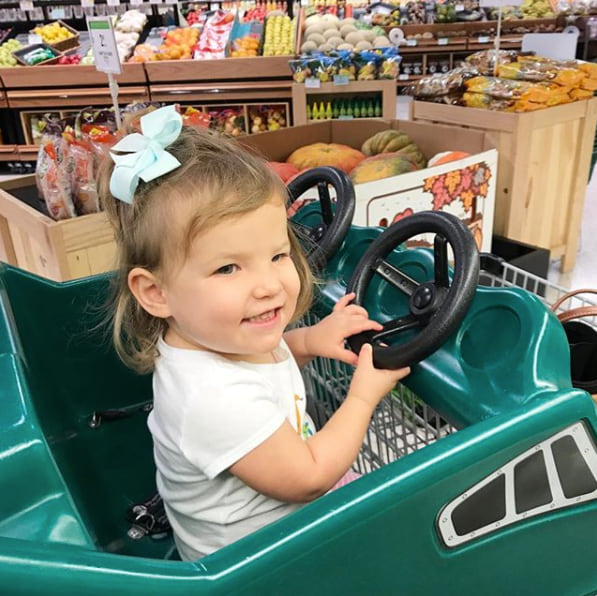
Aside from these two big systems, what about the little random things that keep our household running smoothly? Here’s a list in no particular order:
1. I purge my clothes regularly while brushing my teeth. Yes, you heard that right :) While brushing my teeth, I choose my and June’s clothes for the next day, and that gives me time to consider what in my closet I haven’t worn in a long time. I know this sounds weird, but it works better for me than wholesale purges every few months! Less pressure if I’m only retiring one or two things at a time :)
2. We keep a donation box readily available. It’s in our bedroom, and any ready-to-be-retired clothes go straight into it, as well as any other unwanted clutter that needs to head to Goodwill. Once the box is full, I put it in my car!
3. I’m not afraid to re-gift things. This is not a source of guilt for me! It’s possible to genuinely appreciate a gift and also genuinely know that your home is not the best home for it. I only want to keep the best, the favorite, and the necessary (in the words of Emily Ley!), and to help do that, I freely let things flow to other loved ones. We have a spot in an upstairs closet where we keep these items, and regularly shop it for birthday, baby, shower, or “just because” presents.
4. With our cars, everything that goes in must come out. John is far better at this than I am, but the goal is that every time we get out of the car, everything that’s not supposed to be in there comes out with us: trash, water bottles, receipts, gloves, etc. This is an easy way to keep our cars clutter-free!
5. Our air filters come automatically. FilterEasy sends us two new filters every quarter at prices and quality comparable to buying at the store. We’ve always bought the super strong ones to keep dust and pet hair at bay, so this is an easy hack for something we were already doing. Bonus: they’re a start-up based in Raleigh! :)
6. Our frequently-used products are on stand-by. In addition to Alexa mentioned above, we have a few Amazon Dash buttons placed around the house for easy reorders: razor blades in a bathroom drawer, rinse aid under the kitchen sink, and Chlorox toilet wand refills in the bathroom. This is the future, people.
7. We store lawn care info in a Google Doc. It’s an easy way to track things like when we reseeded our lawn, how many bags of mulch we used, and when things germinated. I’d love to start another one where we can keep snapshots of the info cards that come with each of our plants!
As with all of these posts, I feel like I’m just scratching the surface – so if there’s something you’re curious about, don’t hesitate to ask! Otherwise, I would love to hear your thoughts on our cleaning rhythms!! I have the sense that other people clean more often, but perhaps that’s not accurate!
P.S. Don’t miss Nancy’s post here!
The rest of the series:
Time: Em’s post and Nancy’s post
Finances: Em’s post and Nancy’s post
Home: Em’s post and Nancy’s post
Personal Lives: Em’s post and Nancy’s post
Work: Em’s post and Nancy’s post
Relationships: Em’s post and Nancy’s post
Kids: Em’s post and Nancy’s post
Affiliate links are used in this post!
16 January 2018
Wow, y’all! I figured you would like this series, but I’ve been blown away by the response – I LOVED reading your thoughts on last week’s post on time, so thank you SO much for sharing! Truly.
To catch up any new gals: Nancy Ray and I are writing an eight-part series every Tuesday in January and February covering “how we do it” in eight different areas: the rhythms, habits, and routines that help us get things done and make the space and time for what matters most. You can read more of the backstory here.
Today’s topic is finances! I’m particularly excited about this post for many reasons (obviously), but one is that it really drives home what I love about this series: that you’re hearing from two people with similar hearts but different ways of living them out, showing that there’s no one right way to do things. Anyone who knows Nancy or I knows that we are both extremely passionate about financial literacy and freedom, but the fascinating thing is that “how we do our finances” is in some cases very different.

Let’s dig in! I wanted to begin with a few of the principles that guide John’s and my thinking on money, because all the tools in the world won’t be much help if your thought patterns are constantly conspiring against you. Here they are:
1. Whenever possible, we take advantage of the power of compounding and the time value of money. We want to make our money work for us as hard and as often as possible, which means starting NOW, even if that means starting small. Time is so powerful, and it’s the only part of the wealth equation you can’t make up. More about this here.
2. We remember we can’t judge anyone else’s financial situation from the outside. We might see a coworker going on a European vacation and be tempted to think we should be able to do that, but not realize they carry credit card debt or rent a super-small apartment or never eat out or don’t save for retirement. We try not to make decisions based on comparisons, especially since they’re always incomplete.
3. We believe our money has been entrusted to us. By God, to be clear :) And because we believe that, we feel an extra measure of responsibility to spend, save, and shepherd that money wisely and for the greatest good.
4. We believe money is a tool. It’s not inherently good or evil. I’d liken it to a chainsaw. It is very powerful, and very effective at what it does, but it can’t hammer a nail. You can’t expect money to do things it was never meant to do, like make you happy.
So how do these principles play out on a daily, weekly, monthly, and yearly basis? For us, it all comes back to the budget. We live and die by our budget, because without it, I’m sure we would be in very sorry financial shape. We make an annual budget and track it in a Google Doc. (Note: our doc and how we use it have changed a bit since I wrote that post five years ago, but it’s still a good overview!) It’s a system that requires some upkeep, but we’ve found a few things that make it easier: we commit to updating it twice a month (generally on the 1st and 15th, the same day we pay our credit card bills), and we almost exclusively use cards, so transactions are easy to reference and record.
That’s right, we use credit cards! I wouldn’t recommend them for everyone, but we pay ours off in full twice a month and have never carried a balance. The rewards (2% cash back for us) and the ease of tracking our spending make them the right fit for us. We have three: one predominantly used by John for his expense categories, one predominantly used by me for my expense categories, and one used by both of us for joint expenses (which include most things, including gas, groceries, gifts, dining out, June expenses, vacations, etc.).
We also each have a checking account and savings account (which we both have access to, but our paychecks get deposited into our respective accounts). I pay most of the bills out of mine, so to keep things simple, John simply “levels our accounts” on the 1st and 15th by transferring the difference from his checking to mine, so that we each have the same amount.
Our savings and checking accounts are at Capital One 360. I LOVE CAPITAL ONE 360! I’ve considered writing a Marvelous Money post just about this bank because I love it so much :) Why? The interface is great, there are no fees, and most importantly, they let you open as many savings accounts as you want!! Over the years, we have opened accounts to save for vacations, for our backyard renovation, for a new car, for our wedding, and many other things. You can give each account a unique name and set up automatic transfers each month, making setting aside a pool of money and building it over time fun and mostly painless! Highly, highly recommended. (NOTE that that is a referral link – I get $20 if you sign up, but I would NOT share something we didn’t adore! We’ve been customers since 2006 :))

Another thing that has simplified our finances: our charitable giving account. If you give away money regularly, whether to your church or other organizations, I would highly recommend one. I went into much more detail here, but the reason it helps simplify things is that at tax time, you only have to look one place to itemize your deductions.
I’m not going to chat too much about debt in this post because aside from our mortgage it’s not a huge focus for us right now, but if it is for you, I’d recommend checking out this post which talks about how we paid off my student loans!
Retirement savings are a priority for us, and we both have 401ks we contribute to through work as well as IRAs. Most importantly, we always make sure to contribute at least enough to get the full match our companies offer. Here is my beginner’s guide to 401ks and beginner’s guide to IRAs, if you’re new to this arena! We also use an HSA (Health Savings Account) as an important part of our retirement savings plan, as they are highly tax-advantaged. Might be something to consider if you have a high-deductible health plan!
A number of readers have asked me about 529s and college savings for kiddos recently, so I will likely write a separate Marvelous Money post on that topic in the future. We do have an account for June that we have contributed to, but I wanted to mention here that it is not a priority for us right now, given that we are going so aggressively after our mortgage goal. We feel confident with the overall plan we have, and know that we can make more progress without dividing our focus unnecessarily! Just like when you’re tackling debt, I think it is often most effective to pick one area of focus and go hard after that one instead of trying to implement five different things at once.
Finally, I wanted to briefly share how we divide up the financial responsibilities in our family. I think it’s equally important for each partner to have a role, AND for those roles to be clear and defined. These are ours:
Emily: Bill payment and account maintenance (activating cards, calling customer service, etc.)
John: Taxes, investment strategy, and “R&D,” or bringing new ideas to the table (like our tweaked mortgage plan)
Together: Set yearly budget, record transactions in the budget, and participate in our every-other-month “net worth” meetings
We call them that not because our net worth is so high (ha), but because they are when we look at a global picture of our finances and our budget. We look at what’s in each account, talk about changes to our budget or financial situation, progress we’ve made toward our goals, and more. To be clear, we talk about our finances on a more regular basis than every other month, but this is dedicated time we’ve set apart to cover more in-depth topics.
Friends, I hope this post was helpful for you!! Don’t forget to read Nancy’s post here. I’d love to hear what tool or practice has been most helpful for you in organizing your personal finances! Or, if this post brings up a question for a future Marvelous Money topic, I’d love to hear that, too! :)
The rest of the series:
Time: Em’s post and Nancy’s post
Finances: Em’s post and Nancy’s post
Home: Em’s post and Nancy’s post
Personal Lives: Em’s post and Nancy’s post
Work: Em’s post and Nancy’s post
Relationships: Em’s post and Nancy’s post
Kids: Em’s post and Nancy’s post























